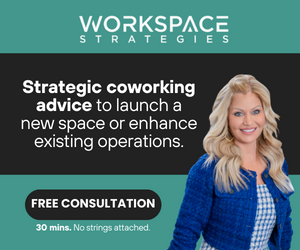- A recent report from workplace software company Robin Powered showed that 46% of businesses are using just half of the office space they own or lease.
- Vacant offices and unoccupied offices are not synonymous; unoccupied offices remain outfitted and still provide revenue, while empty vacant offices don’t.
- Grey space is the limbo in between that typically involves subletting and marketing the space as a flexible or short-term lease opportunity.
Office vacancies have plagued landlords since the pandemic single-handedly escorted professionals to their homes. Since then, the office industry has never looked the same.
Try as they might, landlords have struggled to attract occupants back into their buildings. Offering lavish amenities and state-of-the-art technology may have helped occupancy rates slightly rise, but it isn’t quite enough to offset the losses of the last few years.
A recent report from workplace software company Robin Powered showed that 46% of businesses are using only half — or less! — of the office space they own or lease.
However, this measurement ignores one glaring fact that can distort how the world views office tenants: the difference between unoccupied offices and vacant offices.
Unoccupied Offices vs. Vacant Spaces
On the surface, it would appear that these two categories of office space are synonymous, but in reality, they are very different.
According to Kastle System’s Back To Work Barometer, which measures key swipe entries, office occupancy in March of 2022 averaged at 40% across ten major U.S. cities.
However, vacancies in the U.S. came to 18.1% during the first quarter of 2022, a slight dip from the year prior.
So what exactly is the difference? And why is it important to distinguish the two when we talk about office activity?
Unoccupied Offices
Unoccupied offices refer to spaces that may still be owned or leased by a business, but are not being fully utilized.
There are a multitude of reasons why unoccupied offices have become so prevalent in the real estate industry, but one of the biggest is the pivot to hybrid and remote work models.
Companies are transitioning to brand new work models, leaving them with the challenge of relinquishing, keeping, or slimming down their office space in an effort to accommodate new work modes.
For example, a company may decide that they plan to pivot to a hybrid work model that would see employees come into the office two days a week. However, they may not require the same square footage as when staff were in the office five days a week.
This may lead businesses to cut down on their office occupancy, while still leaving behind tools, furniture and resources in case employees were to return.
While it is uncertain what an occupant may do once their lease is up, so long as there is still a lease tied to the office without much footfall, it is considered unoccupied.
Vacant Spaces
On the other hand, vacant space is the real boogeyman for office landlords.
Office vacancies refer to occupants that have fully abandoned a space, taking all of their belongings. Typically, these offices are up for rent.
Because there is no one tied to the lease, vacant spaces do not generate any revenue as opposed to unoccupied spaces. For vacancies like this, landlords may have a harder time filling in gaps.
That means those costs come out of the landlords’ pockets.
Additionally, a vacant space may not have the same insurance coverage as a maintained, unoccupied space. This leaves offices at higher risk for criminal activity, property damage and inevitably more costs for landlords.
Landlords are eager to fill in vacant offices, oftentimes slashing rent or upgrading the building’s amenities to attract new occupants to the space. In short, office vacancies are a higher risk for building owners.
Where Gray Spaces Fit In
Somewhere in between these empty offices is a phenomenon called the gray space.
Gray spaces refer to the limbo between vacancies and unoccupied space.
For instance, if an occupant decides to leave an office, they may sublease it out in order to continue providing the building revenue.
Research from Savills finds that gray space has more than doubled since the onset of the pandemic, with 106% increase seen in March of 2021.
Many landlords or occupants take the gray space approach because it’s effectively cheaper than signing a brand-new lease. The goal is to fill in the vacancies, so often these spaces are marketed as being on flexible, short-term leases.
Whether it’s signing a new 10-year lease with a tech company, or simply subletting out the office on a shorter basis, gray spaces are a place where landlords can go to buy time until they make their next move.
Think of it as a coworking space’s much more chaotic cousin.

 Dr. Gleb Tsipursky – The Office Whisperer
Dr. Gleb Tsipursky – The Office Whisperer Cat Johnson – Coworking Marketing Maven
Cat Johnson – Coworking Marketing Maven Angela Howard – Culture Expert
Angela Howard – Culture Expert Drew Jones – Design & Innovation
Drew Jones – Design & Innovation Andrea Pirrotti-Dranchak – Competitive Advantage
Andrea Pirrotti-Dranchak – Competitive Advantage Jonathan Price – CRE & Flex Expert
Jonathan Price – CRE & Flex Expert Jeremy Fennema – Tech Innovation Alchemist
Jeremy Fennema – Tech Innovation Alchemist







